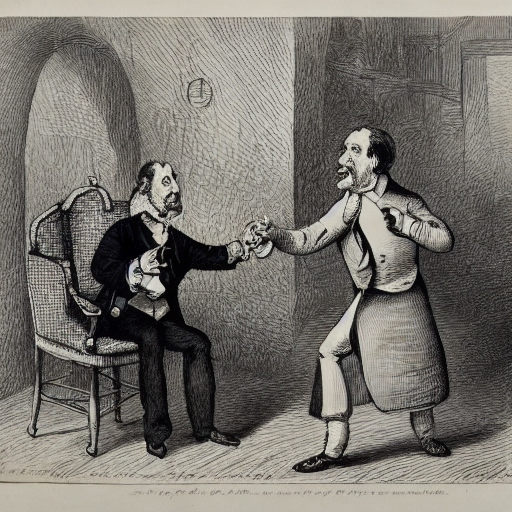
In this article, we delve into the fascinating world of caricatures, exploring their rich history, cultural significance, and the ways in which they have been used to both entertain and incite controversy. From the biting social commentary of George Cruikshank to the iconic images of political figures like Napoleon and Abraham Lincoln, caricatures have played a prominent role in shaping our perceptions of individuals and events throughout history. Whether you're a fan of satire, art, or history, this article is sure to captivate and inform you about the unique and enduring art form of caricatures.
Caricatures are a form of art that exaggerate or distort the physical, moral, or social features of a subject, often for the purpose of humor, ridicule, or criticism. The word "caricature" comes from the Italian word "caricatura," which means "to load" or "to exaggerate." While caricatures can be lighthearted and fun, they can also be a powerful tool for political and social critique. In this article, we will explore the history and significance of caricatures, as well as the controversies surrounding them.
Caricatures have a long history, dating back to ancient civilizations such as the Greeks, Egyptians, and Romans, who used them to highlight physical and social deformities. During the Middle Ages, caricatures were even used in religious manuscripts. Many of the sculptures that decorate the cathedrals of that time have grotesque and burlesque attitudes. After the Renaissance, caricature reappeared in more vigorous form than ever in Italy, with artists such as Leonardo Da Vinci and Carrache the Florentine.
In the 18th century, Pietro Belloti and Pierleone Ghezzi were distinguished caricaturists, while in Germany, Holbein became the most distinguished. In France, Callot was the leader in this art form, and the French revolution of 1789 stirred up caricature anew, with the king and queen being especially attacked. In England, political caricature had freer play than any other country in Europe. The most eminent English caricaturist was Hogarth, followed by Gillray, Bunbury, and Cruikshank. Spain's most notable caricaturist was Goya, and in recent years, Du Maurier in England has won great fame in the field of social caricature. In the US, caricature has had wide development and free scope, and its power as a political agent was never so fully illustrated as during the exposure of the Tweed Ring in New York when public sentiment was largely formed by the sketches of Nast in Harper's Weekly.
Caricatures are often used to criticize politicians, celebrities, and other public figures. They allow artists to express their opinions and views in a way that is both entertaining and thought-provoking. Caricatures have been used to bring attention to social issues and injustices. They can be a valuable instrument in social and political change, as they expose the moral and physical flaws of society and its leaders.
However, caricatures can also be controversial and offensive. In some cases, they can perpetuate harmful stereotypes and reinforce negative perceptions of certain groups of people. For example, caricatures of that exaggerate features like lips and noses have a long history of being used to promote racist attitudes. It's important to remember that caricatures are not always meant to be taken seriously and should be viewed in context. As with any form of art or media, it's up to the viewer to interpret the meaning and intent behind a caricature.
Caricatures can be classified into two categories: the first confines itself to giving prominence to physical deformities and infirmities, while the second is more concerned with vices, weaknesses, or passions. The latter is considered more serious, as it can be used to censure or criticize social and political systems. Caricatures are not just a means of picturesque satire, but they also partake in the character of burlesque and comedy. Caricature can become a cruel personal injury or a redoubtable means of public censure. Its role is to prepare the way for revolutions rather than to reflect them.
One of the greatest caricaturists of social vices and injustices was George Cruikshank.
George Cruikshank was a British caricaturist and illustrator who lived in the 19th century. He was known for his satirical drawings, which often criticized the social and political issues of his time. Cruikshank's work was widely popular and influential, and he is considered one of the most important caricaturists of his era.
Cruikshank was born in London in 1792 and began his career as a caricaturist in the early 19th century. His work was featured in numerous publications, including political and satirical magazines like Punch and The Comic Almanack. He is perhaps best known for his illustrations for the novels of Charles Dickens, including Oliver Twist and A Christmas Carol.
Cruikshank's satirical drawings often focused on issues of social justice, including the treatment of the poor and working class. He was a strong advocate for temperance and campaigned against the consumption of alcohol, which he saw as a major social ill. His satirical drawings often featured drunken and debauched characters, and he was particularly critical of the alcohol industry.
In addition to his social and political commentary, Cruikshank was also known for his skill as an artist. He was a master of caricature, and his drawings often featured exaggerated physical features and expressive gestures. His style was characterized by bold lines and dramatic contrasts of light and dark.
Cruikshank's work was hugely influential in his time and continues to be celebrated today. His satirical drawings remain relevant and thought-provoking, and his influence can be seen in the work of many contemporary cartoonists and illustrators. He is remembered as a master of his craft and a powerful voice for social justice and reform.
Updated February 20, 2023








